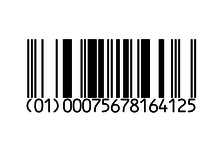GS1 DataBar


GS1 DataBar is a family of symbols most commonly seen in the GS1 DataBar Coupon. Formerly known as Reduced Space Symbology (RSS-14), this family of barcodes include:
- Symbols intended for retail point of sale scanning:
- GS1 DataBar Omnidirectional
- GS1 DataBar Stacked Omnidirectional
- GS1 DataBar Expanded
- GS1 DataBar Expanded Stacked
- Symbols that are not intended for retail Point-of-Sale scanning:
- GS1 DataBar Truncated
- GS1 DataBar Limited
- GS1 DataBar Stacked
All GS1 DataBar barcodes encode a GTIN-12 or GTIN-13 in a 14-digit data structure. In order to make the GTIN-12 or GTIN-13 a 14-digit data structure, a leading zero or zeros is filled to the left of the GTIN. GS1 DataBar Omnidirectional, GS1 DataBar Stacked Omnidirectional, GS1 DataBar Expanded, and GS1 DataBar Expanded Stacked have omnidirectional scanning capability. GS1 DataBar Truncated, GS1 DataBar Stacked and GS1 DataBar Limited can only be scanned by a linear hand held or imaging scanning device: they cannot be scanned by omnidirectional scanners and are intended to be read by handheld scanners.
GS1 DataBar Stacked Omnidirectional is designed to condense the GTIN information into a more compact and square barcode suitable for use on smaller packages (such as the label stickers on fresh produce).
GS1 DataBar Limited, GS1 DataBar Stacked and GS1 DataBar Truncated are designed for very small item identification and are mainly used in the healthcare industry. Each encodes a GTIN-12 or GTIN-13 in 14-digit data structure. Only GS1 DataBar Limited uses an indicator digit 1.
In addition to encoding Application Identifier (01) GTIN, GS1 DataBar Expanded and GS1 DataBar Expanded Stacked can encode additional GS1 Application Identifiers such as sell-by date, weight, and lot number. Each symbol has a capacity of up to 74 characters. These attributes can help in controlling shrinkage, optimizing product replenishment, and improving the traceability of a product at the point of sale. They are seeing increased use in manufacturers' coupons. Starting June 2011 GS1 Databar use is mandated for coupons and the use of UPC-A must be discontinued.[1]
The symbology is formally defined as ISO/IEC 24724:2006.
The name was changed from RSS to GS1 DataBar due to the potential for confusion with Really Simple Syndication.[2]
References
- ↑ http://www.honeywellaidc.com/promos/0710_Ask_the_Expert_landing/images/61510GS1DataBarPres_20100709T175210Z.pdf
- ↑ Eric Decroix (2007-02-27). "Reduced Space Symbology (RSS) is now called GS1 DataBar" (PDF). GS1 Global Office (press release). Retrieved 2007-03-17.
- GS1 General Specifications
External links
- GS1 DataBar Information at GS1
- Overview of GS1 Databar and Databar Coupons
- An overview of DataBar symbologies

